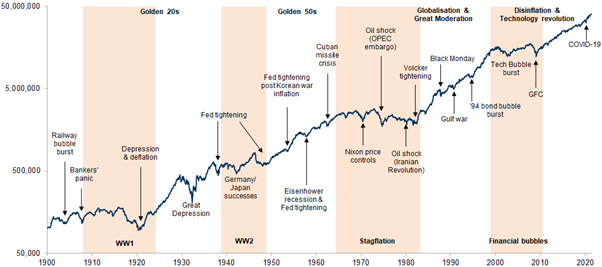As equity markets continue to broadly shrug off geopolitical turmoil, the same big picture debates are coming back to the fore, perhaps with a few minor tweaks.
Are we in a mid-cycle slow down whereby central banks can adjust monetary policy whilst manufacturing a soft landing?
Or, is inflation so significantly progressed, that the speed of central bank neutralisation or tightening of monetary policy will result in global recession?
Whilst the purpose of this note is not to wade into the above debate, the point is the last cycle saw a growth/inflation mix with good growth and anchored inflation, which was unusually supportive of 60/40 portfolios where bonds rallied alongside equities.
Going forward the outlook for the growth/inflation mix is markedly different.
Inflation is clearly no longer anchored and the risk to growth, in our opinion; is down. It is simply the degree that is up for debate.
From here, given the starting valuation from an equities perspective, returns from a typical 60/40 portfolio are likely to be lower going forward and more vulnerable to growth and rate shocks. An environment of anchored inflation has allowed central banks in the past to err on the side of caution and buffer the business cycle proactively.
However, going forward, with higher inflation in play, in our opinion in order for the ‘central bank put’ to come into play, a larger ‘growth shock’ is required. Or in other words the ‘central bank put’ has moved further ‘out of the money’ than investors have previously enjoyed.
Poor profit growth coupled with sharp declines in valuations, often exacerbated by high inflation, can weigh on real returns, whereas strong growth with anchored inflation explains overshoots and strong real 60/40 returns in the 1920s, 1950s and since the GFC.
Goldman Sachs recently published on this topic with the chart below highlighting historical periods where 60/40 portfolios delivered poor to negative real returns. In fact, the strongest bull markets for 60/40 portfolios often ended with elevated valuations were usually followed by ‘lost decades’. Whilst this analysis is US centric, given the positive correlation with the domestic market, the analysis in our view is relevant to Australian investors.
Real total return performance of US60/40 portfolio
(monthly rebalancing, orange shading denotes ‘lost decade’)

Source: Goldman Sachs Global Investment Research
On that sobering note, what should investors do?
First and foremost, investors need to be ‘invested’.
Equities are a claim on nominal growth and in most macro scenarios, have the best chance of delivering positive real returns.
While larger bond or cash allocations reduce the risk of large capital losses in the near term, they don’t help to achieve attractive real returns in the long run.
Equities will always remain the workhorse of any investor portfolio.
Investors need to let their asset allocation do its role in supporting overall portfolio returns whilst managing risk.
We often see investors endeavour to time the market and sit in cash and wait for risks to lower.
Risk is ever-present; there is rarely a time when the path to equity markets is certain.
Returns are delivered by time in market and not timing the market.
Cash returns whilst improving are unlikely to deliver meaningful positive real returns in the near term, in our view.
This is in part why equity markets have remained so resilient in the face of geopolitical uncertainty. Low real bond yields continue to support valuations and the hunt for yield.
For equities in particular, There Is No Alternative (TINA) remains a key motivation for demand.
While equities appear expensive relative to their own history, they still appear attractive vs. bonds, in our view.
With elevated equity valuations, even if they are supported by macro conditions, there remains a risk of a prolonged period of poor real returns in the event of a large and sustained increase in long-dated real yields. But being underinvested also increases risk of poor real returns.
To achieve acceptable real returns with acceptable risk, investors need to manage risks that come with higher equity allocations and the drag on real returns from cash. Importantly there are a myriad of ways to accomplish this; via both diversification across markets (private and public) and broader alternative investments.
Additionally, investors can access real returns by forgoing liquidity; long term investors have a natural advantage in this regard.
Within traditional asset classes, diversification across regions, sectors, styles, duration and credit quality can further improve the risk/reward of multi-asset portfolios.
Diversification via real asset exposure is no doubt a recent investment trend, especially given the natural inflation hedges which can be found within this asset class.
Real assets include commodities (soft and hard), real estate, and infrastructure and will be a topic of future notes.
Finally, some private markets assets offer compelling returns.
Companies are on average staying private for longer resulting in meaningful value being created in private markets well before these companies hit public markets. Accessing this pool of value creation can meaningfully add to risk adjusted returns for investors.
The views expressed in this article are the views of the stated author as at the date published and are subject to change based on markets and other conditions. Past performance is not a reliable indicator of future performance. Mason Stevens is only providing general advice in providing this information. You should consider this information, along with all your other investments and strategies when assessing the appropriateness of the information to your individual circumstances. Mason Stevens and its associates and their respective directors and other staff each declare that they may hold interests in securities and/or earn fees or other benefits from transactions arising as a result of information contained in this article.



